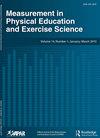数字膝关节角度计测量膝关节运动范围的可靠性和有效性
IF 1.9
4区 教育学
Q2 EDUCATION & EDUCATIONAL RESEARCH
Measurement in Physical Education and Exercise Science
Pub Date : 2021-11-22
DOI:10.1080/1091367X.2021.2004150
引用次数: 3
摘要
摘要:测角术通常用于评估关节运动范围(ROM)。最普遍的方法是手动通用测角仪(UG),它被认为耗时且难以处理。数字角度计EasyAngle(EA)是为了改进和简化ROM的评估而开发的。本研究旨在评估EA测量膝关节主动和被动屈伸的可靠性和有效性。可靠性在测试-再测试模型中进行评估,而有效性通过比较EA和UG的测量进行测试。36个膝关节角度(18个个体)按标准化顺序进行测量。EA在测量主动/被动屈曲(ICC 0.994/0.994)和伸展(ICC 0.978/0.987)方面表现出几乎完美的可靠性。EA在主动/被动弯曲(r=0.969/r=0.97)和中等至高测量主动/从动伸展(r=0.751/r=0.892)方面的有效性非常高。EA是测量膝关节角度的可靠、有效和有效的评估工具。进一步的研究应该验证其他关节和运动方向的这些发现。本文章由计算机程序翻译,如有差异,请以英文原文为准。
Reliability and Validity of a Digital Goniometer for Measuring Knee Joint Range of Motion
ABSTRACT Goniometry is commonly used to evaluate joint range of motion (ROM). The most widespread method, a manual universal goniometer (UG), is considered time-consuming and difficult to handle. The digital goniometer EasyAngle (EA) was developed to improve and simplify the evaluation of ROM. This study aimed to evaluate the reliability and validity of EA measuring active and passive flexion and extension of the knee joint. Reliability was assessed in a test–retest model, while validity was tested by comparing measurements from EA and UG. Thirty-six knee angles (18 individuals) were measured in standardized order. EA showed almost perfect reliability measuring active/passive flexion (ICC 0.994/0.994) and extension (ICC 0.978/0.987). EA’s validity was very high in active/passive flexion (r = 0.969/r = 0.97) and moderate-to-high measuring active/passive extension (r = 0.751/r = 0.892). EA is a reliable, valid, and effective assessment tool for measuring knee angles. Further studies should verify these findings for other joints and movement directions.
求助全文
通过发布文献求助,成功后即可免费获取论文全文。
去求助
来源期刊

Measurement in Physical Education and Exercise Science
Medicine-Orthopedics and Sports Medicine
CiteScore
4.20
自引率
33.30%
发文量
24
期刊介绍:
The scope of Measurement in Physical Education and Exercise Science (MPEES) covers original measurement research, special issues, and tutorials within six substantive disciplines of physical education and exercise science. Six of the seven sections of MPEES define the substantive disciplines within the purview of the original research to be published in the journal: Exercise Science, Physical Activity, Physical Education Pedagogy, Psychology, Research Methodology and Statistics, and Sport Management and Administration. The seventh section of MPEES, Tutorial and Teacher’s Toolbox, serves to provide an outlet for review and/or didactic manuscripts to be published in the journal. Special issues provide an avenue for a coherent set of manuscripts (e.g., four to five) to collectively focus in-depth on an important and timely measurement-related issue within the scope of MPEES. The primary aim of MPEES is to publish high-impact manuscripts, most of which will focus on original research, that fit within the scope of the journal.
 求助内容:
求助内容: 应助结果提醒方式:
应助结果提醒方式:


